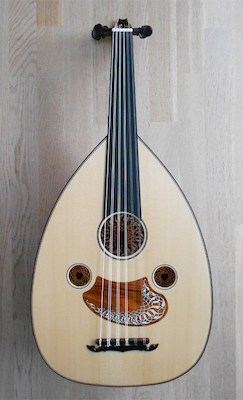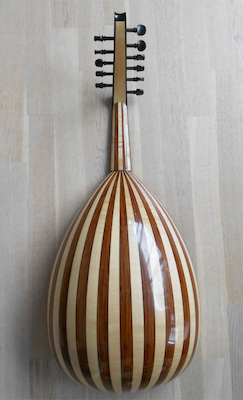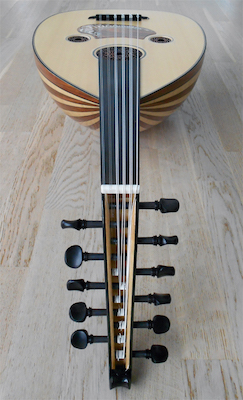I discovered the oud while on vacation in Istanbul and was instantly hooked. The oud is one of the most well known and highly regarded instruments of the Near and Middle East, and has been around for centuries. Yet relatively few people outside of the Near East, Middle East, North Africa, and some in the Balkans have ever heard or seen an oud. This is unfortunate, as in my view the oud is one of the most beautiful instruments there is.
The oud is the ancestor of the European lute, but it is played with a pick. Like the violin and cello, it has no frets, allowing an infinite variety of tones to be played. In Ottoman/Turkish music theory there are 53 possible tones per octave, rather than the 12 that are found in Western music. And in Arabic music theory there are 24 tones per octave. In reality, many of the tones are not fixed in either system, and move up and down depending on the composition, improvisation, or the taste of the musician.
The music most commonly played on the oud is based on the makam system, an incredibly rich, varied, and complex modal system. Each makam has a "scale" composed of various trichords, tetrachords, and/or pentachords, particular tonics or starting notes, particular dominant notes, and a particular melodic direction. There are hundreds of makams, each with unique and different flavors, and experienced musicians may be comfortable with 50 or more.
Due to the size and diversity of the Ottoman Empire, there is a great variety of traditional repertoire for the oud that dates back many centuries. Famous Ottoman composers came not only from Turkey and the Middle East, but also from Greece, Armenia, Central Asia, Northern Africa, and Europe. In addition to composed pieces in different genres (classical/art music, songs, dance music, sufi hymns, etc.), improvisation is an essential part of makam music.
There are a number of websites about the oud in English, and an active discussion forum where anyone interested in the oud can find a great deal of information. The purpose of this site is to expose more people to the oud, and eventually to provide some free information that might be useful to new players. Makam music is extremely complex and difficult to fully grasp without in-depth study. That combined with differences between "Turkish" and "Arabic" ouds, different tunings, different methods of notation, and different approaches to theory make learning the oud and makam music somewhat daunting. As a teacher myself (not of music), I hope to be able to simplify a few concepts here that took me longer to figure out than necessary.
The Sound
Here are a few videos to demonstrate the sound of the oud. I'll likely change them regularly...
Myself playing the Hicaz Mandira by Lavtacı Andon:
My friend Eric Hussey and I playing a Nikriz Longa by Cemil Bey:
A piece I saw the Panorama Jazz Band perform, called A Glezl Schnaps:
The Makam System
The makam system is a complex modal system used in Ottoman/Turkish and Arabic music, but somewhat different in each tradition. There are a number of books that cover makam music theory in great detail, along with at least a couple of great websites. I'll try to provide an easy to understand overview on my makam music page, with links to more in-depth books, documents, and websites.
Oud Tuning
Turkish and Arabic ouds are tuned differently in general, and there are numerous different tuning options for each speicifically. With both, the first four courses of strings (highest in tone) are nearly always tuned in fourths, whereas the last two bass courses are tuned in a variety of different ways. For more information, my oud tuning and notation page lists some of the different tunings along with the pros and cons of each. Additionally, Turkish musical notation is unfortunately not written for concert pitch, so the notes you use/see when you tune your oud will not match what you actually play if you're reading Turkish sheet music. This can be extremely confusing for beginners (it certainly was for me!), and I'll try to provide as much clarity here as possible.
Buying an Oud & Taking Lessons
I bought my current ouds from Faruk Türünz, in Istanbul. I've seen and played a number of ouds from well known luthiers, both Turkish and Arabic, and I have yet to see one that I prefer to those made by Faruk and his craftsmen. So if you'd like to buy an oud, I would highly recommend getting one from him.
If you'd like to take lessons, which in my view are essential to making efficient progress, I very highly recommend Zeynel Demirtaş and Mavrothi Kontanis, both of whom are outstanding teachers and musicians and offer Skype lessons to students anywhere in the world.
Oud Gallery
Quality ouds not only have amazingly beautiful sound, but the instruments themselves are works of art. On my oud gallery page I'll post photos of some of my favorite instruments.
Resources
Makam music has been around for centuries and a huge body of material has been written on it, from books and websites to dissertations and sheet music. On my oud resources page I'll provide links to the best resources I know of. If you have or know of additional quality resources please feel free to contact me and let me know.


